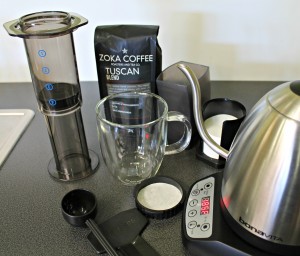Much like Coffee Kevin, our crew tests and evaluates every brewing gadget large or small and we share our feedback. Some equipment is strictly for commercial use: Does anyone need 240 cups of coffee per hour at home? Maybe, it depends on how many coffee drinkers live with you — I know that I could put a serious dent in that! Some coffee crazes easily translate from commercial cafes to your kitchen counter, yet due to sheer volume or prohibitive cost, some do not.
In conjunction with the World Barista Championship that was held during the Melbourne International Coffee Expo in May 2013, another (much quieter!) competition occurred: The World AeroPress Championship. Now here’s a coffee trend that everyone can try on for size. The initial set up for this brew method runs about $150 for an AeroPress coffee maker, pack of filters, variable temperature kettle and kitchen scale. All you need to bring to the kitchen table is a little caffeinated curiosity, your coffee and a cup.
Here’s a look at the winning “recipe” from barista Jeff Verellen of Belgium. We were interested to find out how it tasted compared with our standard AeroPress brew, so we tried it ourselves. Here are the steps we followed:
• 17 grams of coffee or espresso ground slightly coarser than drip
• Rinsed paper filter
• AeroPress in regular position (some people use an inverted technique)
• 50 grams of water at 182F for the bloom
• Bloom for 40 seconds
• Nicely wet all grounds and lightly agitate it
• Very slowly add 215 grams of water at 175F for about 30 seconds
• Press very gently for about 30 seconds
Jeff mentioned he favored bolder coffees for use in the AeroPress so we chose a flavorful espresso blend that we regularly enjoy. 17 grams corresponds to about 1 rounded AeroPress scoop, but we weighed ours to be certain of the measurement. His grind, however, is somewhat controversial: Unless something was lost in translation, he reportedly used a coarser grind than drip, while conventional wisdom has the grind somewhere between espresso and fine drip.
Water temperature is not what you’d expect either. The familiar 200F temperature threshold is not achieved and it still creates a proper extraction. You can experiment yourself to confirm this. With a variable temperature kettle it is easy to get the right (lower) temperature for extraction. You could also use a regular kettle with a glass measuring cup and an inexpensive drink thermometer. We placed the AeroPress over a double-wall glass mug and it was beautiful to watch and listen to the resulting coffee droplets. In about five minutes, we had a single cup of coffee with the AeroPress from start to finish. The aroma was a little more subtle, but the coffee was smooth, even and full of sweet caramel notes — just as we had hoped.
Then I compared these delicious winning results to my co-worker Jess’ morning AeroPress coffee habit:
• 34 grams of coffee ground slightly finer than drip (2 rounded AeroPress scoops)
• AeroPress in regular position
• No filter rinse, no pre-infusion
• Fill to the (4) measure with water around 185F
• Nicely wet all grounds and use the included stir stick
• Wait 30 seconds
• Push down hard with even pressure, about 30 seconds
The included AeroPress instructions indicate for two scoops to fill the tube with water to the (2) measure and to make a concentrate rather than filling to (4) with this dosage. The resulting concentrate can then be diluted (as if!). Even with her predilection for up-dosing and lack of dilution, she brewed a cup that was not bitter or sludgy. You have to love a device that still operates well whether you follow the printed directions or not.
Besides price, taste and ease of use, there is also the portability factor: It is lightweight and virtually unbreakable. The AeroPress is a practical option for anyone who would like to take his or her fresh cup of Joe on the go. I have heard tales of AeroPress prepped successfully in campgrounds and college dorms — even on a commercial airliner mid-flight! The aftermath is also manageable to clean because the spent grounds are pushed out after the extraction and it is fairly solid like an espresso puck for easy disposal. A quick hot water rinse and occasional soft scrub are all that is required to clean.
While any coffee brewing method can be taken to scientific extremes, the versatility of this simple plastic device continues to amaze. Right side up, inverted, pre-infusion, paper versus metal filters –you can try all of the tricks of the trade to see what tastes best for your coffee or espresso blend. What I’ve outlined here are just two of a seemingly endless number of variations.
 The AeroPress is fun to use and that should come as no surprise since it is from the same Stanford inventor behind the Aerobie Flying Disc. While it may be easy to dismiss the device based on looks (think Habitrail meets water pipe), it makes a seriously good cup of strong coffee. Recently, my local cafe started offering house roasted single origins prepped via AeroPress; I can’t think of a more glowing endorsement from the world of specialty coffee. For home or cafe, the AeroPress is here to stay. Don’t knock it till you try it!
The AeroPress is fun to use and that should come as no surprise since it is from the same Stanford inventor behind the Aerobie Flying Disc. While it may be easy to dismiss the device based on looks (think Habitrail meets water pipe), it makes a seriously good cup of strong coffee. Recently, my local cafe started offering house roasted single origins prepped via AeroPress; I can’t think of a more glowing endorsement from the world of specialty coffee. For home or cafe, the AeroPress is here to stay. Don’t knock it till you try it!

Samantha Joyce is a writer for Seattle Coffee Gear and enjoys sharing her knowledge of all things coffee



Dear Kevin
I haven’t seen you comment (yet) on the now famous and ubiquitous CLEVER COFFEE DRIPPER. Everyone is raving about it-Oren’s sells it, Cafe grumpy, Gimme Coffee, etc etc. I was wondering if you have a preferred technique for using it. The manufacturer recommends a 4 minute steep using a fine grind, but at least two experts, Jason Dominy and Nich Cho say to use a coarse grind with a 2:45 second steep-a completely opposite approach. I need you to weigh in on this. Thanks
Hi Michael,
I’m eager to test The Clever Coffee Dripper. Usually a manufacturer or sales distributor sends one but I’ve never received it. We do not charge to test but nor do we fund reviews with advertising. In the main it’s been a good system of keeping reviews objective. Once I receive one I spend 90 days with it. So please be patient.
Dear Kevin,
Since the Clever is not all that “new” it is possible they are not sending them to reviewers anymore. It is too respected to pass over so possibly Oren or somebody else might lend or give you one for testing. (I tried to be patient!). A french press without the grit? Wow!
Hello Kevin, First of All thank you very much for making yourself available to us. I have been using a cheap coffee maker for some time Now and its about time to upgrade. I do realize that the best coffee makers cost upward of $250.00, but I am not willing to spend that much money right Now. Anyways, I came acorss the Bodum Bistro at my local Jcpenny for $77.00. Is this a good deal? I have heard good things from the experts but bad things from customers.
Hello Edwin. You are welcome. It is time to upgrade. The Bodum Bistro for $77. is a good price. I’ve had one for a while. It did very well in my review. It gets to industry standard brewing temperature and stays there. It appears to use the same heating element as the Technivorm and that’s one of the best ever made. Thanks to an efficient metal filter it brews a full 1.2L batch in 6 minutes. Once you get your grind just right, it is capable of brewing a very good cup. It falls short of the Technivorm only in its build quality. I prefer paper to metal filters and glass carafes to thermal metal ones, but those are personal preferences, and frankly, most consumers likely prefer the choices Bodum made. Nothing stopping you at that price.